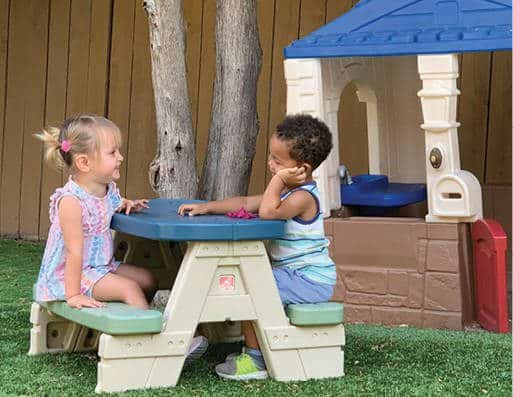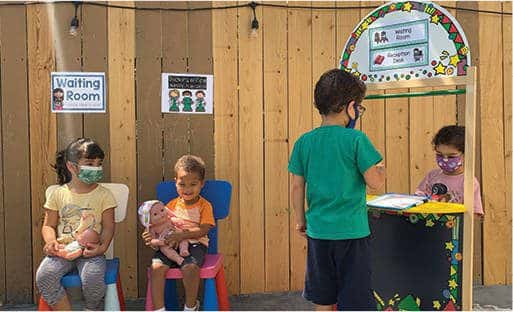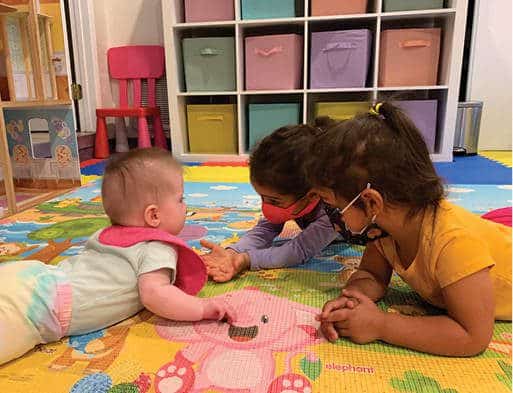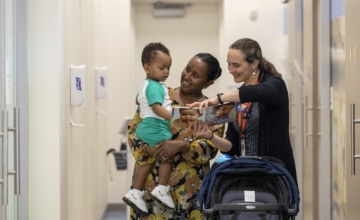Eileen Manoukian, Gem Educare, Los Angeles, California

Abstract
The eruption of the COVID-19 pandemic at the end of 2019 changed norms in human behavior and how business is conducted throughout the world. In this article, the author shares her experiences as a home-based child care provider during the COVID-19 pandemic. Multiple challenges and disruptions, which were faced at the onset of the pandemic, are ones that she continues to grapple with as a business owner, director, staff developer, parent educator, early childhood curriculum developer, teacher, and caregiver. She also provides her perspectives on challenging disruptions that family members—especially young children—have endured during 2020–2022.
In November 2019, I was a proud home-based child care provider in Los Angeles, California. I couldn’t keep up with the demand from parents and considered expanding my program to an additional location. My multicultural, multilingual, and emergent curriculum program, based on fostering emotional intelligence in young children, was in such demand that I was getting at least 10 requests for enrollment every day. My waitlist was full for 2 years because expectant parents were enrolling their unborn children. I began the required processes for expansion of my program with the state and the county, and at the same time started looking for a suitable property for a second location. Things could not have been better! While I was looking for the right property and inquiring about funding requirements, the news reports and social media rumors started revealing information about the outbreak of the COVID-19 virus being spread around the world. Just like everyone else, I followed the news and communicated with the parents of the children in my care frequently. I had a couple of children whose parents were physicians and other medical professionals; thus, I was informed every day of what was happening in the medical field regarding the pandemic. I never thought about or was ready for what happened on 15 March 2020.
The Ides of March
Shakespeare’s words “beware the ides of March” took on meaning when California residents received the stay-at-home order—overnight—without any prior warning. I was left with two children, whose parents were designated as essential personnel, and I was unable to say proper goodbyes to the children who didn’t attend my child care after that day. My plans of expansion were shattered in the blink of an eye and now I even had to find a way to just survive the situation and keep the facility open. The waitlist meant nothing anymore! The situation was as shocking for the children and their parents as it was for me. The children could not understand why they couldn’t be with the caregivers and their friends who had previously been with them during most of their waking hours. The uncertainty of the situation, the fears around safety and security, and the unknown future outcomes due to COVID-19 were all factors that contributed to the anxiety and stress we felt from this disruption.
Disruption and Impact on Young Children
After the stay-at-home order was issued and all but two of the children under my care had to stay home, I decided to have virtual classes with the rest of the group (14 children and 3 teachers) twice a week for a minimum of 20 minutes. Because most of the children were under 4 years old, I decided to offer opportunities for singing, dancing, making crafts, and reading stories. My goal was for children to stay connected with their community of friends and teachers by seeing, hearing, and interacting with other children, including the two children in my care. I was trying to create a virtual social group for children. Some of them were happy to see their friends and were able to follow the directions of the teacher, but children who had socialization challenges prior to the pandemic had a very difficult time engaging with the virtual classrooms. These children needed undivided attention from the teachers, which was impossible through the virtual group environment.
Technology was a great means for me to stay in touch with each child and communicate with parents or other family members in the home. I felt it was necessary for all children, even infants and toddlers, to see my face and hear my voice at least once a week so as not to feel abandoned by me. I wanted children to know that I cared about them, and my love and affection had not changed toward them. I would make video and audio contact with each child individually every week during the period that the stay-at-home order was in effect, in addition to the virtual classes and social group video sessions. All parents or family members, such as grandparents in the home, stayed in contact with me through text messaging, phone calls, and video calls.
Technology had both positive and negative effects on children’s development during the pandemic. The American Academy of Pediatrics (2016) suggests up to 1 hour of screen time with high-quality programs for children between 2 and 5 years old and no screen time for children under 2 years old. Too much screen time for young children can affect physical, cognitive, language, and social–emotional development in children (American Academy of Pediatrics, 2016). Screen time has been linked to obesity, irregular sleep schedules and shorter duration of sleep, behavioral problems, loss of social skills, violence, and less time for play (American Academy of Pediatrics, 2016). However, because of the circumstances created by social distancing during the pandemic, children had to use more screen time for school, family interactions, and entertainment. Technology had become the gateway to learning, virtual social indications, visiting family and friends virtually, and one of the safest ways to interact with others. It is not yet clear how the increase in virtual interactions and a corresponding decrease in face-to-face interaction may affect the physical, social, cognitive, and language development of young children, but preliminary research is revealing many areas of concern.
Disruptions in Children’s Development and Mental Health
The outbreak of the COVID-19 pandemic changed life as we knew it and, because we are still in the pandemic, for very young children, this has been life as they know it. Children under 5 years old are one of the most vulnerable groups given the importance of the first 5 years of life on all areas of growth and development. A preliminary study by the National Institute for Early Education Research found that “rates of social-emotional problems reported by parents on a standardized scale, continued to rise. Conduct problems, peer problems, and prosocial behavior problems were all reported at levels twice or more [than] the 10% normally expected” (Jung & Barnett, 2021, p. 3).
Young children’s world shrunk overnight from offering them a vast universe to limiting them to the rooms in their homes and TV and computer screens. It was not only frightening and difficult to understand why their entire world had changed, it was also very frustrating for them not to be able to play and touch and experiment with everything. The new norm for them had turned into not touching anything outside of their personal belongings, not hugging or kissing anyone other than their parents, and visiting extended family members from afar or through the phone and computer screen, unable to make any contact or enjoy any playtime with them.
After a year and a half since the outbreak of the COVID-19 pandemic, I can now see changes in young children’s behaviors. This is true especially for those children who were born right before the pandemic or during the pandemic. Recently a 2-year-old toddler joined my program. From the first day of her attendance, she showed signs of social anxiety and stress. It was very important to me to remain in close communication with her parents and give her the time and the space she needed to feel safe at the child care facility, to develop trust in us, to learn social skills, and to respond positively to other children. Her parents were very cooperative and helpful, and after a couple of months she started interacting with the teachers and other children without the anxiety that she felt when she first started attending.
Disruptions in Families
I was working with 14 families when the pandemic started. Each of the families with children in my care had unique challenges that arose around their daily lives related to entertaining, teaching, and being with their children all day long. Beyond those, there are several examples of disruptions and professional and personal challenges that members of these families went through that I witnessed firsthand. One of the families was expecting their second child and overnight both parents lost their jobs; they were both working in the entertainment industry. Another one of the families had three children under the age of 9 years and one of the spouses developed a medical challenge right before both husband and wife, who were working in the real estate industry, lost their incomes. Parents of a child under my care were both physicians and one was working directly with COVID patients. The primary challenge for them was to keep family members healthy while one parent was being exposed to the virus on a daily basis. Most of the families I have worked with since the beginning of the COVID-19 pandemic have faced financial challenges, many have suffered from illnesses and loss of loved ones, and some have faced separation of family members due to work or travel restrictions. When the stay-at-home orders were placed, parents had to fulfill many roles for their children as their teachers, friends, and coaches. Family members became the only social group that children could interact with physically. Siblings previously spent most of their days in separate classrooms or schools but now had to spend all their time with each other. Homes became classrooms and at the same time work offices for parents. Managing children’s school schedule and their own work schedules became extra challenges for parents who had to work from home. Parents with multiple children of different ages were faced with a more challenging situation. All these new and unforeseen challenges caused extra stress and anxiety for families. Parents’ stress and anxiety directly affected their young children.
Financial Disruptions
There were many struggles that I initially experienced at the beginning of the pandemic, and there have been numerous challenges that have arisen over my last 2 years as a child care provider. Naturally, financial issues were some of the most pressing concerns. My first and foremost priority has been to keep children under my care and their families safe. At the beginning of the pandemic, the state issued an order for all the family child care providers to only accept essential workers’ children if they decide to stay open. My decision was to keep my child care program open and provide services to the parents who really needed care for their children so they could save lives. My enrollment for the first 4 months was reduced to two children. I had to ask my teachers to stay home to keep them and their families healthy and safe. The children who were attending my child care program had physician parents, some of whom were directly working with COVID cases. I felt it was my duty to care for their children so they could help those in need without worrying about their children’s safety.
I was lucky to have parents who offered to pay the tuition of their children for several months ahead of time, and some parents who were willing to pay the tuition although they decided to keep their children home so I wouldn’t have to close my program due to financial problems. Having a financial background and a long-term business plan helped me keep the doors open for the families who needed my services. The state and the child care provider’s union were also hard at work to provide us with resources. The union was able to partner with the school district to provide food to child care providers.

Young children’s world shrunk overnight from offering them a vast universe to limiting them to the rooms in their homes and TV and computer screens. Photo: shutterstock/Tavarius
I experienced support, love, and unity during the pandemic. My friends, parents of children in my care, family members, and anyone who knew I had family child care assisted me in any way they could. Some offered to pick up food for children from the school districts, others brought sanitizers and hygiene products. I felt that the entire community was coming together to help me keep my business open and provide service to children.
State, nonprofit organizations, the county, and the federal government have provided several grant and loan programs which have been very useful. I was able to bring back only one of the teachers after 4 months. By January 2021 I brought back all three of the teachers and started working at full capacity. My waitlist started growing again. It is more challenging to serve at full capacity during COVID than it was before because of the restrictions and the safety measures that must be taken into consideration. We had to implement several new protocols to keep children and families safe. We also had to have a plan in case we had to close the program temporarily. I was fortunate to have a parent who is a pediatrician and because of my great relationship with all parents, I could contact her for any health-related issues and get immediate advice at any time. To keep everyone as safe as possible, I tried to move most of the activities outdoors. Having a large outdoor play area was very helpful. We even fed the children outside. We rearranged the sleeping accommodations, trying to keep children apart at a safe distance from each other.
Disruption in Business Operation
The fear of the rapid spread of the virus made a significant change in the operation of the business. Children’s exposure to potential carriers of the virus had to be minimized. Because it was impossible to know who might be carrying the virus, I came up with a new protocol. At first, I brought back only one of the teachers, restricted parents’ access to the property, began using disposable dishes and cups, and checked every child’s temperature at the entrance along with any signs of cold such as a runny nose, cough, or sneezing. I would send home any child with the first sign of a cold, and they could not return without a negative COVID test.

To keep everyone as safe as possible I tried to move most of the activities outdoors. Photo courtesy of Eileen Manoukian
One of the teachers and I divided our responsibilities to minimize health risks. She oversaw diaper changes, and I prepared the meals. I trained my teachers on how to interact with children and their parents and how to help ease their anxiety and fear. It was my responsibility to reassure every teacher of their safety and financial well-being. We had to regroup and come up with creative activities, games, and plans to teach the children 2 years and older why it was important to wear a mask, keep the mask on, and wash their hands regularly and often without frightening them. It was important to consider the needs of infants and toddlers for language acquisition. We really did not know how wearing a mask most of the day would affect their mimicking because they could not see our lip movements. There is not enough research or concrete information on how children’s language acquisition has been affected by their limited exposure to observing facial expressions and movements of the mouth.
Disruption in Education
The pandemic had a devastating effect on children’s education, especially young children’s education. Globally, 1.6 billion children have been affected by the pandemic, UNICEF estimated in their 2021 report. In early March 2021, only 51 countries offered in-person education, according to data collected with the Global Education Recovery Tracker. Young children were challenged with virtual learning because of their short attention span and limited knowledge and ability to navigate the virtual classroom. Some of the most important skills that young children need to get ready to start their academic schooling and future success in life are social–emotional skills. They need to be able to separate from their parents, to sit for an extended period, and listen to the teacher. They need to learn to share with others, wait for their turn, express their needs, and regulate their emotions. Cantor et al. (2021) proposed that whole child development involves valuing a child’s physical development and emotional state, as well as social skills such as relationships that directly influence their learning. Many speculated that staying apart from their friends while playing and not seeing the caregivers’ entire face, especially the movements of the lips, made it difficult for young children to build trust and mimic their caregivers for language development purposes. Rules such as keeping a 6-foot distance and for caregivers and children 2 years and up to always wear a mask contributed to children’s physical health and safety, but caused confusion for young children.
Other Disruptions Caused by the Pandemic
When someone tests positive for the COVID-19 virus, not only does that person’s life change, other people’s lives were also affected. Every time a parent tested positive for COVID I had to inform all families and get tested myself immediately. In one case, after consulting with two physicians, my decision was to keep the child care program open because no one else from the family of the infected parent tested positive. That parent’s child, however, had to be quarantined for 21 days, per doctors’ orders. This incident caused a lot of inconvenience, stress, and anxiety for the other families. In another case, a fully vaccinated parent tested positive for COVID-19 right after schools were opened in August 2021. She informed me as soon as she had her results. We followed all the protocols and because this parent’s child was attending child care and tested positive, I had to close the facility for 10 days to comply with CDC orders. This case disrupted many families’ lives. They all had to quarantine their children for 10 days. Most of them missed 10 days of work, which in turn caused financial difficulties for them. They all were under stress and fear of getting sick.
Another example occurred in January 2022. At pick-up time, one of the parents informed me that his wife tested positive for COVID. About half an hour after closing I received a call from the parent who tested positive informing me that one of their twin children also tested positive after leaving the facility on that same day. Per policy, I had to inform all parents that their children had been exposed to COVID; however, this time there was confusion because the official protocol was changing frequently. Because it was after working hours, I was unable to contact any of the governing departments or access information online to learn current guidelines. I made the decision, based on a previous protocol, to close for 5 days and required that every child and staff member bring a negative test which had been completed the day before their return. Unfortunately, there was a shortage of COVID test kits at that time. I recognized this shortage in time and ordered several test kits. I offered those to all parents and staff members free of charge. Other than the twin sibling of the infected child, none of the other children tested positive for COVID. Only one of the teachers, who was fully vaccinated, tested positive after 5 days, and I asked her to stay home and quarantine herself for an extra week and bring a negative test result when she returned to work. To maintain my close relationship with the children and families, I once again offered virtual classes with activities the children enjoyed—singing, movement, story reading and telling, and craft and cooking activities—for 2 hours of video chat interactions every day during the closure of the program. Because most children are very young, I decided to stay on video chat for 2 hours a day and invite the parents to bring the children on as they wished. One of the twins was hospitalized for a couple of days and she was happy to join the chat. It was great to see the child join from the hospital bed and interact with her friends and teachers!
Some of the effects of the pandemic are overlooked. A study in Canada found that more than half of the families with young children reported changes in their habits, such as eating more snacks; 51% of children decreased their physical activities; and 87% of children engaged in increased screen time (TV, tablets, and computers; Carroll et al., 2020). These changes in habits can directly affect children’s physical, cognitive, social–emotional, and language development. In a study conducted in seven European countries, parents reported strained relationships within their households, elevated parental alcoholism/drug abuse due to increased stress and anxiety, dissatisfaction with online education, unsuitability of virtual learning for the youngest children, and inadequate support for homeschooling (Thorell et al., 2021). The economic instability brought forth by the onset of the pandemic in 2020 is another factor that will affect young children’s lives for years to come. In 2020, the United Nations estimated that 42–66 million additional children will live in extreme poverty even if the pandemic is contained.
At this point in the pandemic, some of the most pressing challenges are keeping up with the ongoing changes to the guidelines and safety protocols; limiting parents’ and other adults’ visitation to a minimum; making crucial decisions on a daily basis; and being flexible, creative, and resourceful to deal with unforeseen challenges that might arise every day. One of the most challenging issues is to get in contact with a live person at different organizations or departments to ask questions about situations related to COVID. With the ever-changing variants of the coronavirus, it is more and more challenging to keep children and their families safe. Each variant spreads differently and affects children differently. Keeping up with the information about the spread of the virus and its effects on children is a challenge by itself. Families and staff members are making the conscious decision to send their children to child care or come to work knowing that there is always a chance of getting sick.
Concluding Thoughts
The effects and disruptions of the COVID-19 pandemic on the global community, and especially on young children, are vast and still unknown. It is unclear how the disruptions in children’s physical health, mental health and well-being, growth and development, education, and family life will have lasting impacts. This pandemic also brought together the communities, friends and families, and the society in general, to help and support each other. Taken together, both the challenges and the opportunities for growth will have a profound influence on young children, their families, and those who have worked so hard to support them through the COVID-19 pandemic.

It is more challenging to serve at full capacity during COVID than it was before because of the restrictions and the safety measures that must be taken into consideration. Photo courtesy of Eileen Manoukian
Within the last 2 years I have learned how resourceful, resilient, and creative I am when faced with challenges that no one even imagined could happen 2 years ago. I also learned how flexible, resilient, and adaptable children are. Children accepted wearing the masks as if masks are part of their clothing items. They comply with all the new regulations without any resistance. They have learned how to wash their hands properly and often. They have learned to play with their friends at a distance and how to cover their mouths when coughing if they are outside without a mask. Children have taught me a lot in the last 2 years. They have affirmed my belief that children should be put first, that their physical and emotional health and safety are paramount, and that I can take baby steps as I deal with each unique situation one day at a time with love and care.
Author Bio
Eileen Manoukian, MBA, EdD, is an international parenting coach/mentor, an early childhood educator in private practice, and the founder/director of Gem Educare, a child care establishment/preschool in Los Angeles, California. She has more than 15 years of experience in business coaching, banking, and finance. She found her calling in life while she volunteered as a teacher and caregiver in a facility for low income, homeless, or orphaned children in South Africa. After realizing her calling, she began researching and observing early childhood programs and teaching methods during her travels around the world. Dr. Manoukian earned her doctoral degree from Walden University specializing in early childhood education. She is a member of Mensa, the National Association for the Education of Young Children, National Association for Family Child Care, and ZERO TO THREE. She was involved as a youth mentor with the Big Brother–Big Sister organization for more than 10 years and Girl Scouts for more than 15 years. Dr. Manoukian values diverse educational programs due to having lived and worked in five countries and speaking five languages as she engaged in the community. Her research interests include the importance of emotional intelligence in young children, social–emotional learning skills in young children, and how early childhood educators support children’s school readiness skills. She is the co-host for a television and radio parenting show and frequently appears as an expert consultant on several other shows.
Suggested Citation
Manoukian, E., (2022). Beware the ides of March: How the pandemic changed the way home-based child care providers do business. ZERO TO THREE Journal, 42(3), 31–36.
References
American Academy of Pediatrics. (2016). Media and young minds. link
Cantor, P., Learner, R. M., Pittman, K. J., Chase, P. A., & Gamperts, N. (2021). Whole-child development, learning, and thriving: A dynamic systems approach. Cambridge University Press.
Carroll, N., Sadowski, A., Laila, A., Hruska, V., Nixon, M., Ma, D. W. L., Haines, J., and on behalf of the Guelph Family Health Study. (2020). The impact of COVID-19 on health behavior, stress, financial and food security among middle to high income Canadian families with young children. Nutrients, 12(8), 2352. link
Jung, K., & Barnett, W. S. (2021) Impacts of the pandemic on young children and their parents: Initial findings from NIEER’s May-June 2021 preschool learning activities survey [Research report]. National Institute for Early Education Research. link
Thorell, L. B., Skoglund, C., de la Peña, A. G., Baeyens, D., Fuermaier, A. B., Groom, M. J., Mammarella, I. C., van der Oord, S., van den Hoofdakker, B. J., Luman, M., de Miranda, D. M., Siu, A. F. Y., Steinmayr, R., Idrees, I., Soares, L. S., Sörlin, M. Luque, J. L., Moscardino, U. M., Roch, M., Crisci, G., & Christiansen, H. (2021). Parental experiences of homeschooling during the COVID-19 pandemic: Differences between seven European countries and between children with and without mental health conditions. European Child and Adolescent Psychiatry. link link
UNICEF Global Educational Recovery Tracker. (2021). New global tracker to measure pandemic’s impact on education worldwide. link
United Nations. (2020). The impact of COVID-19 on children. link




